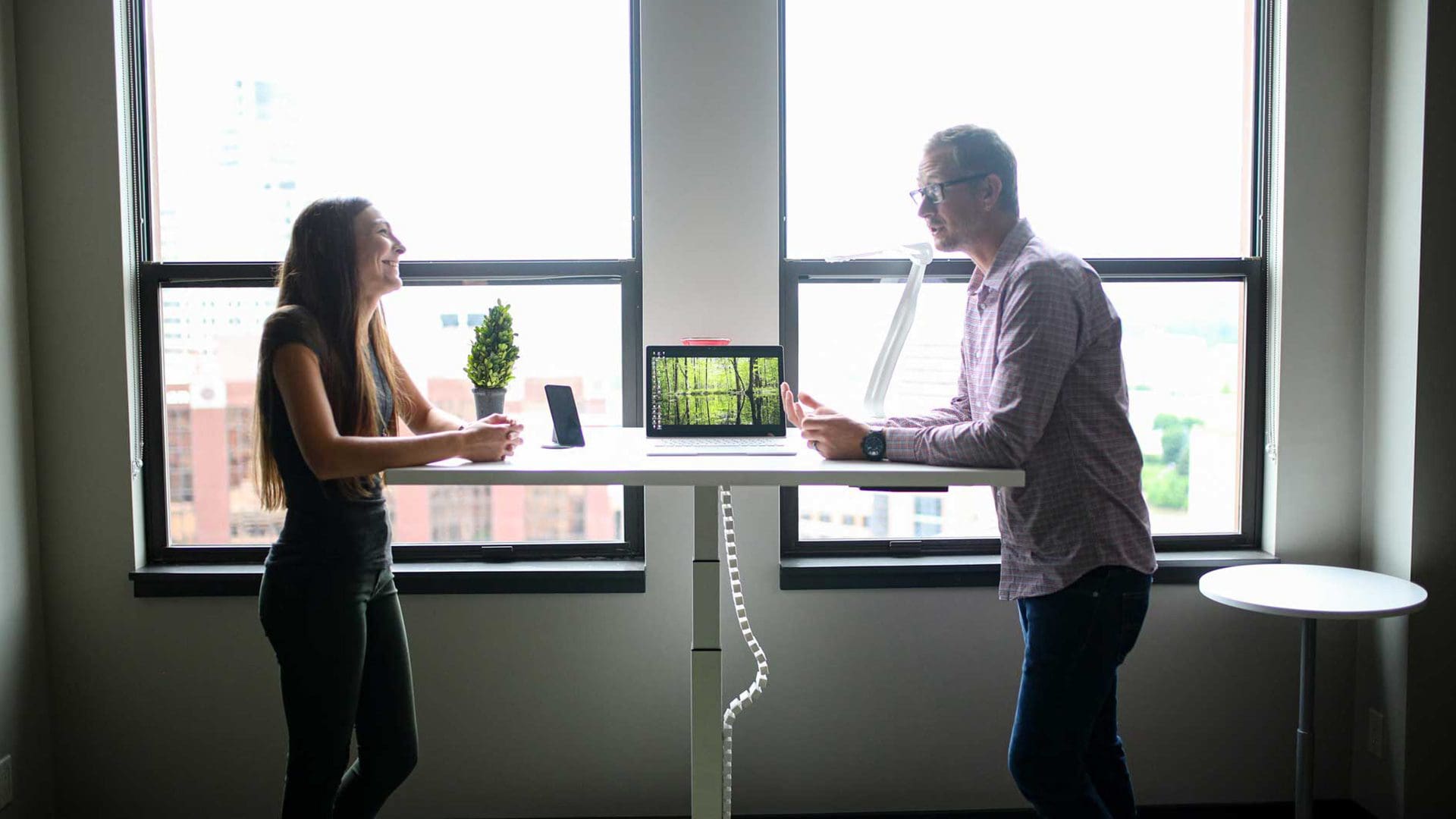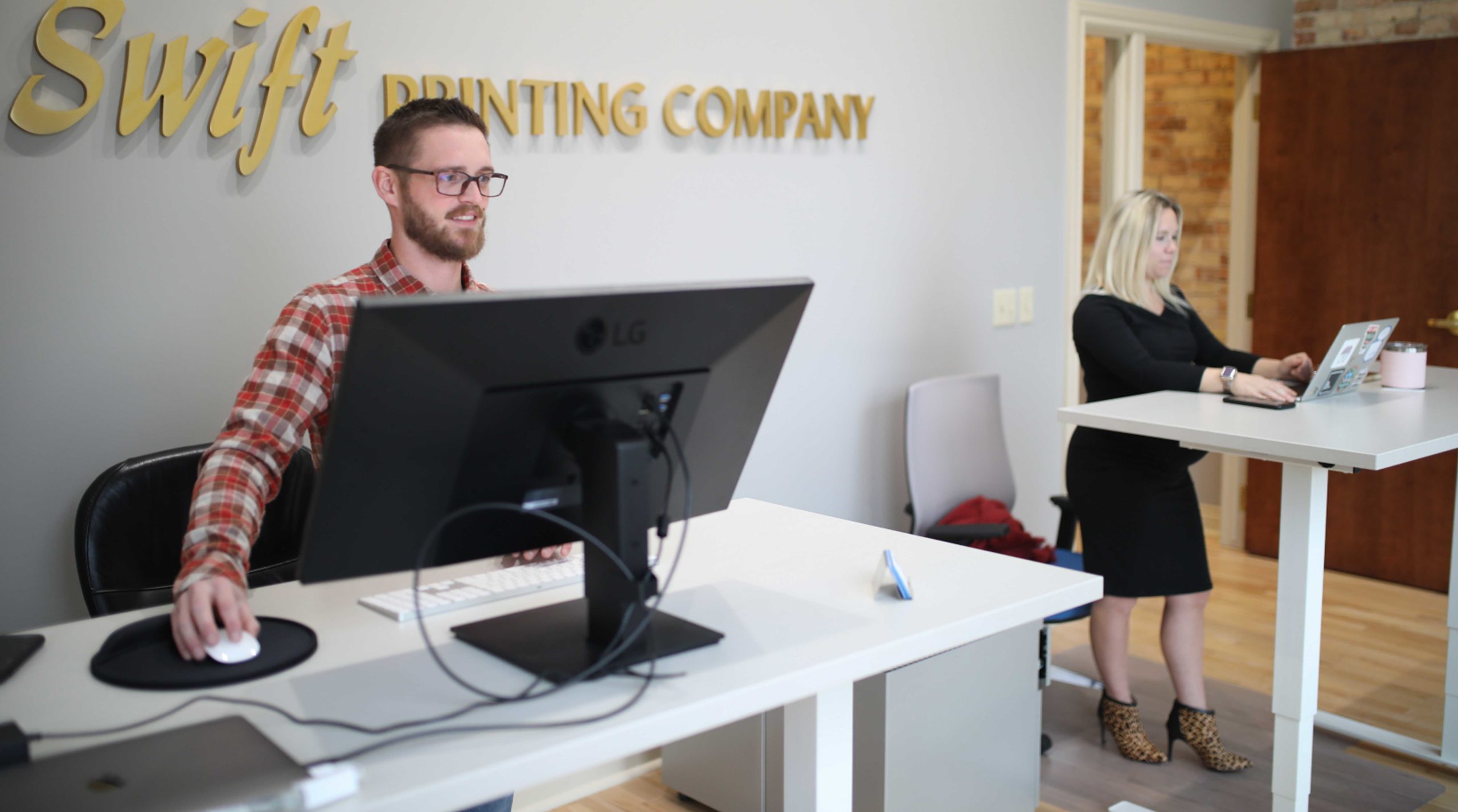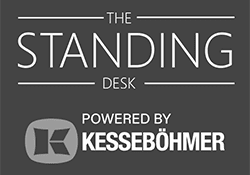What Are Standing Desks?
Desk jobs traditionally involve a lot of sitting, but these days more and more people are opting for a standing desk instead. These taller desks are intended to get you on your feet – at least some of the time. Even high-achieving companies like Google, Apple, and Facebook have made the switch to standing desks a standard part of their office environment, and health benefits are one of the main reasons why.
Are Standing Desks Good for You?
Yes, incorporating a standing desk into your daily work routine is great for your health. We know that sitting all day can be detrimental to your physical, mental, and emotional health. Regular periods of standing can make you more productive and make working more enjoyable.
6 Health Benefits of Standing Desks
Switching to a standing desk can be helpful for just about anyone, and these are some of the reasons why.
1. Improved Posture
Standing allows you to achieve better posture, mitigating muscle aches and strains that can distract you from getting into a productive workflow.
2. Decreased Stress Levels
Muscle tension can lead to headaches and insomnia, which can cause or exacerbate stress. Using a standing desk to alleviate being slumped in a chair for hours improves not only your actual work performance and experience but also your life outside the workplace.
3. Decreased Chance of Type 2 Diabetes
Standing reduces the harmful effects of blood sugar and fat metabolism, which directly affects an individual’s risk of diabetes. One study published in Diabetes Care found that breaking up prolonged sitting reduced glucose, insulin, and NEFA responses in women at risk of type 2 diabetes.
4. Healthier Weight
Standing at a desk does burn slightly more calories than sitting, and some research indicates slight weight loss. The main way that standing can help weight loss is that it increases the likelihood of moving about (shifting weight, pacing, etc.), which further increases calorie expenditure.
On top of that, standing also gives you more energy, so you’re more likely to end your workday with a workout, rather than crashing onto the couch as a result of feeling sleepy and sluggish.
5. Decreased Risk of Heart Disease
Regular bouts of standing can reduce blood sugar levels and cholesterol, aiding in the fight against heart disease. Regular periods of standing can have an even greater impact than occasional vigorous exercise when it comes to heart health.
6. Reduced Need for Caffeine
Because standing naturally increases energy levels, users can cut back on coffee, which can amp up anxiety and often ends in an afternoon slump.

Stand Up Desks from The Standing Desk
The Standing Desk offers a variety of standing desks designed to accommodate a wide range of people with different health and lifestyle priorities.
Pneumatic Desks
Quick, quiet pneumatic desks use air-powered cylinders to raise and lower the desk surface without the need for electricity. Thoughtful material choices – like highly recyclable steel frames and recycled wood substrate surfaces – make these air-powered desks a health boost for the planet, as well.
Add a set of casters, and a pneumatic desk allows maximum mobility, with no cord to keep you tethered to an outlet.
The Klöud
If you plan to keep your full desktop PC on top of the desk, consider the Kloud. A Kloud desk features our most powerful pneumatic lift system, so it can be calibrated to lift loads up to 150 lbs., all on its own – quickly and with no effort on your part. If you have plenty of space, opt for the larger 30” x 60” work surface to combine that strong lifting assistance with plenty of desktop working area.
With an adjustable range of up to 48 inches – plus another 1.5 inches if you add casters – the Kloud desk helps some of the tallest standing desk users maintain healthy posture.
The Lüften
The flexible Luften desk, with the visually light appeal of twin center columns, has the hidden strength to hold up to 200 lbs. locked. Loads heavier than 40 lbs. may require a small amount of manual lifting assistance. If you have the space, the large 30” x 60” work surface gives you plenty of room to spread out.
The Ändern Pneumatic
Mobile workers appreciate our Andern single column pneumatic desk – a minimalist floating desk perfect for a laptop and a single monitor. The Andern’s slightly scaled-down work surface (30” x 48” or 24” x 40”) gives it a smaller footprint to fit handily in cozier spaces.
Electric Desks
Electric desks are strong, durable desks that use electric power to raise and lower the desk surface. The electric power boost makes these some of the most robust sit-stand desks available, and the brushless motor means they’re easy on the ears as well.
The Recken
For multiple monitors or heavy loads up to 250 lbs., the Recken desk does all the work while you stand and sit as often as you like. In large spaces, a work surface of up to 30” x 60” means you can have everything you need right there.
The Ändern Electric
A heavy-lifting electric desk with a smaller footprint, the Andern Electric desk has a lift capacity of up to 150 lbs. A 30” x 48” or even 24” by 40” work surface means this hard-working desk fits easily into tighter quarters.
Frequently Asked Questions (FAQ)
Is Standing Better Than Sitting?
Sitting gets a bad rap because of the fact that office jobs have become increasingly sedentary in the past few decades, which contributes to an overall epidemic of sitting. In truth, there’s a time and a place for both standing and sitting. The key is to find the best of both worlds: an ergonomic, easily adjustable sit stand desk that encourages you to do both.
Is a Standing Desk Good for Lower Back Pain?
Yes. For office workers, sitting at a desk is often the source of lower back pain. Studies have shown that standing desks are one measure that can help decrease chronic lower back pain over time.
Switching between sitting and standing guarantees shifts in posture that can reduce inactivity and allow you to naturally move to the most comfortable position. Indeed, our bodies work best when we can switch positions whenever joint pain or muscle fatigue prompts us to.
Is Standing Good for Your Heart?
Yes. We know that extended sitting increases the harmful effects of blood sugar and fat metabolism, which directly affects an individual’s risk of heart disease. Standing is one way to help reduce the risk.
An enzyme called lipoprotein lipase breaks down fat in the blood and processes it for muscles to use during activity. According to a study of exercise physiology, inactivity suppresses lipoprotein lipase, which leaves fat in the blood and contributes to an increased risk of heart disease. In fact, sitting reduces lipoprotein lipase production by about 90%. To make sure that your body can use fat as designed, rather than storing it – stand up!
Does Standing Burn Calories?
Yes, standing burns more calories than simply sitting still, because more muscles are engaged. One study showed that, on its own, standing burned about 8 more calories per hour than sitting, a small expenditure that adds up over time.
There’s a reason that even the smallest exertions have an impact on our energy expenditure throughout the day. Moving helps fat-burning enzymes to stay activated, which in turn burns more calories than remaining sedentary. Over weeks and years, it all adds up. If you add other movement to your workstation, such as an under-desk treadmill or a desk bike, even more calories are burned.
Is It Good to Stand All Day?
No. In fact, standing all day can be just as damaging as sitting all day, causing tightness and discomfort in the legs and back. Studies show that prolonged standing is associated with a number of problems, including lower back pain, fatigue, and discomfort. However, many standing desk users do like to stand for hours at a time, once they’ve built up to it.
How Long Should I Stand a Day?
The exact right ratio of sitting to standing will differ from person to person. Many ergonomic experts recommend that standing desk users start slowly, working up to standing about 5-15 minutes out of every hour.
Standing, walking, and moving at least 2 hours in an 8-hour workday confers the most benefit. And remember that any movement during the day counts – trips to the coffee pot or the conference room, a walk around the office or the house, a few brief stretches. A standing desk just makes it easier to meet your overall goal.







